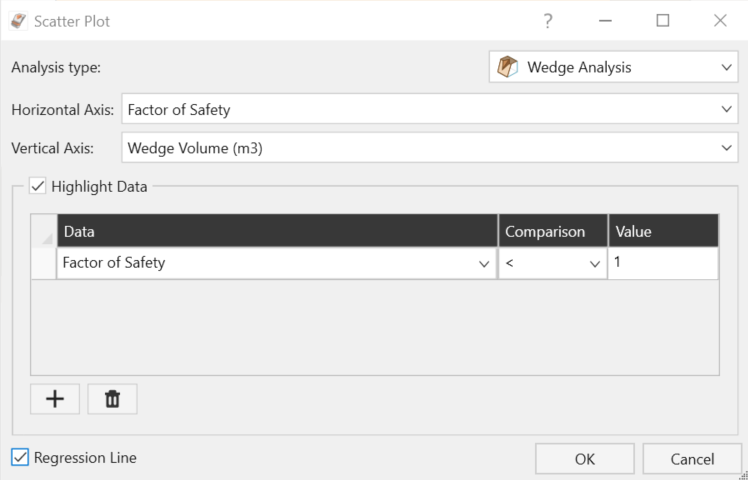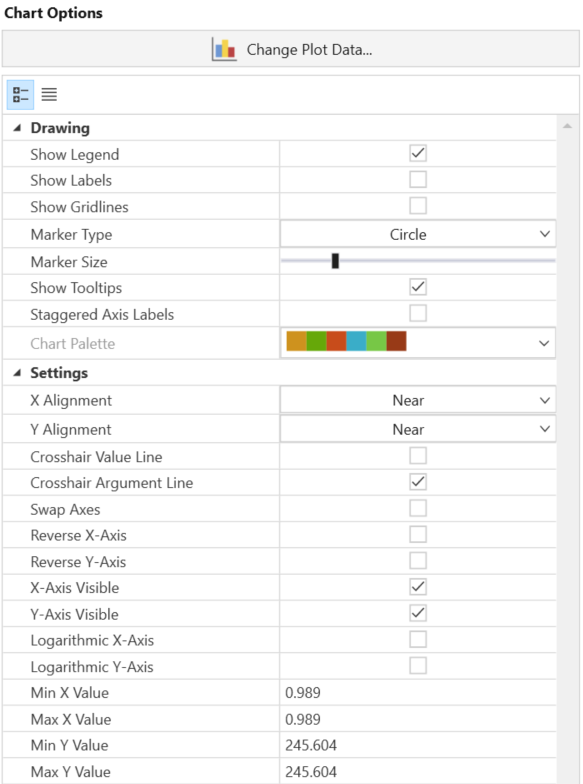Scatter Plot
A Scatter Plot allows you to plot any two variables against each other on the same plot. Typically, the Scatter Plot is used to plot computed data (e.g., Factor of Safety) versus input data to observe the correlation between the two.
To plot a Scatter Plot for either a Probabilistic or Deterministic Analysis in RocSlope2:
- Select Results > Charts > Scatter

- In the Scatter Plot dialog, select an Analysis Type (Wedge, Planar, or Toppling) from the first drop-down list in the dialog.
- Select a Horizontal Axis and a Vertical Axis variable from the respective drop-down lists.
- You can choose to highlight data on the plot, according to user-defined criteria, by selecting the Highlight Data checkbox, and defining your criteria. See below for details.
- Select the Regression Line checkbox to fit a best fit line through the data set.
- Select the OK button to generate the scatter plot.

Highlight Data
To highlight any subset of data on the Scatter Plot:
- Select Chart > Chart Options > Highlight Data

- Select a Data variable from the drop-down list.
- Select an operator (<, <=, >, >=, Range).
- Enter the numerical value(s) defining the data you would like to see highlighted.
- When you select OK, data which fits your selection criteria will be highlighted on the scatter plot in a different colour with a legend. The highlight criterion will be listed at the top of the scatter plot.
Correlation Coefficient
The Correlation Coefficient indicates the degree of correlation between the two variables plotted. The Correlation Coefficient can vary between -1 and 1 where numbers close to zero indicate a poor correlation, and numbers close to 1 or -1 indicate a good correlation. Note that a negative correlation coefficient simply means that the slope of the best fit linear regression line is negative.
Alpha and Beta
Alpha and beta represent the y-intercept and slope, respectively, of the best fit linear Regression Line to the scatter plot data. The display of the linear regression line can be toggled on or off by selecting the Regression Line option.
Chart Data
The following functionality is available in the Chart Data tools:
- Change Data
 prompts the Scatter Plot dialog to appear, allowing you to change the data viewed on the plot.
prompts the Scatter Plot dialog to appear, allowing you to change the data viewed on the plot. - Chart in Excel
 prompts an Excel application to open with exported data in columns. A chart object duplicating the chart in RocSlope2 will also appear.
prompts an Excel application to open with exported data in columns. A chart object duplicating the chart in RocSlope2 will also appear. - Copy Data
 allows you to copy and paste the data to another spreadsheet or word file.
allows you to copy and paste the data to another spreadsheet or word file.
Chart Options
The Chart Options tools in the menu bar contains a variety of options for adjusting the appearance of the Scatter Plot:
- Highlight Data

- Regression Line

The Chart Options pane on the left side allows you to modify the graph via the drawing/settings. The drawing options allow you to change labels, while settings allow you to adjust the graph settings such as axis alignment, min/max, etc.

Right-Click Options
Many different options are available if you right-click on a Scatter Plot. For example:
- Select the Change Plot Data
 option, and the Scatter Plot dialog will appear, allowing you to change the data viewed on the plot.
option, and the Scatter Plot dialog will appear, allowing you to change the data viewed on the plot. - Plot in Excel
 : you can either right-click a chart or click the Chart in Excel button in the toolbar. An Excel application will open, and the data will be exported in columns. A chart object duplicating the chart in RocSlope2 will also appear.
: you can either right-click a chart or click the Chart in Excel button in the toolbar. An Excel application will open, and the data will be exported in columns. A chart object duplicating the chart in RocSlope2 will also appear. - Copy Chart Image
 : this allows you to copy and paste the chart as an image.
: this allows you to copy and paste the chart as an image. - Copy Data to Clipboard
 : this allows you to copy and paste the data to another spreadsheet or word file.
: this allows you to copy and paste the data to another spreadsheet or word file.